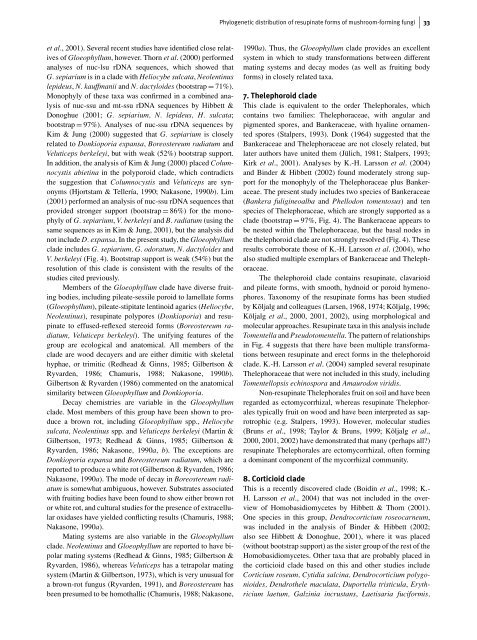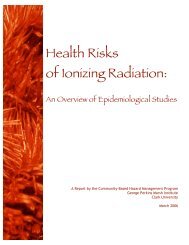The phylogenetic distribution of resupinate forms ... - Clark University
The phylogenetic distribution of resupinate forms ... - Clark University
The phylogenetic distribution of resupinate forms ... - Clark University
You also want an ePaper? Increase the reach of your titles
YUMPU automatically turns print PDFs into web optimized ePapers that Google loves.
et al., 2001). Several recent studies have identified close relatives<br />
<strong>of</strong> Gloeophyllum, however. Thorn et al. (2000) performed<br />
analyses <strong>of</strong> nuc-lsu rDNA sequences, which showed that<br />
G. sepiarium is in a clade with Heliocybe sulcata, Neolentinus<br />
lepideus, N. kauffmanii and N. dactyloides (bootstrap = 71%).<br />
Monophyly <strong>of</strong> these taxa was confirmed in a combined analysis<br />
<strong>of</strong> nuc-ssu and mt-ssu rDNA sequences by Hibbett &<br />
Donoghue (2001; G. sepiarium, N. lepideus, H. sulcata;<br />
bootstrap = 97%). Analyses <strong>of</strong> nuc-ssu rDNA sequences by<br />
Kim & Jung (2000) suggested that G. sepiarium is closely<br />
related to Donkioporia expansa, Boreostereum radiatum and<br />
Veluticeps berkeleyi, but with weak (52%) bootstrap support.<br />
In addition, the analysis <strong>of</strong> Kim & Jung (2000) placed Columnocystis<br />
abietina in the polyporoid clade, which contradicts<br />
the suggestion that Columnocystis and Veluticeps are synonyms<br />
(Hjortstam & Tellería, 1990; Nakasone, 1990b). Lim<br />
(2001) performed an analysis <strong>of</strong> nuc-ssu rDNA sequences that<br />
provided stronger support (bootstrap = 86%) for the monophyly<br />
<strong>of</strong> G. sepiarium, V. berkeleyi and B. radiatum (using the<br />
same sequences as in Kim & Jung, 2001), but the analysis did<br />
not include D. expansa. In the present study, the Gloeophyllum<br />
clade includes G. sepiarium, G. odoratum, N. dactyloides and<br />
V. berkeleyi (Fig. 4). Bootstrap support is weak (54%) but the<br />
resolution <strong>of</strong> this clade is consistent with the results <strong>of</strong> the<br />
studies cited previously.<br />
Members <strong>of</strong> the Gloeophyllum clade have diverse fruiting<br />
bodies, including pileate-sessile poroid to lamellate <strong>forms</strong><br />
(Gloeophyllum), pileate-stipitate lentinoid agarics (Heliocybe,<br />
Neolentinus), <strong>resupinate</strong> polypores (Donkioporia) and<strong>resupinate</strong><br />
to effused-reflexed stereoid <strong>forms</strong> (Boreostereum radiatum,<br />
Veluticeps berkeleyi). <strong>The</strong> unifying features <strong>of</strong> the<br />
group are ecological and anatomical. All members <strong>of</strong> the<br />
clade are wood decayers and are either dimitic with skeletal<br />
hyphae, or trimitic (Redhead & Ginns, 1985; Gilbertson &<br />
Ryvarden, 1986; Chamuris, 1988; Nakasone, 1990b).<br />
Gilbertson & Ryvarden (1986) commented on the anatomical<br />
similarity between Gloeophyllum and Donkioporia.<br />
Decay chemistries are variable in the Gloeophyllum<br />
clade. Most members <strong>of</strong> this group have been shown to produce<br />
a brown rot, including Gloeophyllum spp., Heliocybe<br />
sulcata, Neolentinus spp. and Veluticeps berkeleyi (Martin &<br />
Gilbertson, 1973; Redhead & Ginns, 1985; Gilbertson &<br />
Ryvarden, 1986; Nakasone, 1990a, b). <strong>The</strong> exceptions are<br />
Donkioporia expansa and Boreostereum radiatum, which are<br />
reported to produce a white rot (Gilbertson & Ryvarden, 1986;<br />
Nakasone, 1990a). <strong>The</strong> mode <strong>of</strong> decay in Boreostereum radiatum<br />
is somewhat ambiguous, however. Substrates associated<br />
with fruiting bodies have been found to show either brown rot<br />
or white rot, and cultural studies for the presence <strong>of</strong> extracellular<br />
oxidases have yielded conflicting results (Chamuris, 1988;<br />
Nakasone, 1990a).<br />
Mating systems are also variable in the Gloeophyllum<br />
clade. Neolentinus and Gloeophyllum are reported to have bipolar<br />
mating systems (Redhead & Ginns, 1985; Gilbertson &<br />
Ryvarden, 1986), whereas Veluticeps has a tetrapolar mating<br />
system (Martin & Gilbertson, 1973), which is very unusual for<br />
a brown-rot fungus (Ryvarden, 1991), and Boreostereum has<br />
been presumed to be homothallic (Chamuris, 1988; Nakasone,<br />
Phylogenetic <strong>distribution</strong> <strong>of</strong> <strong>resupinate</strong> <strong>forms</strong> <strong>of</strong> mushroom-forming fungi 33<br />
1990a). Thus, the Gloeophyllum clade provides an excellent<br />
system in which to study transformations between different<br />
mating systems and decay modes (as well as fruiting body<br />
<strong>forms</strong>) in closely related taxa.<br />
7. <strong>The</strong>lephoroid clade<br />
This clade is equivalent to the order <strong>The</strong>lephorales, which<br />
contains two families: <strong>The</strong>lephoraceae, with angular and<br />
pigmented spores, and Bankeraceae, with hyaline ornamented<br />
spores (Stalpers, 1993). Donk (1964) suggested that the<br />
Bankeraceae and <strong>The</strong>lephoraceae are not closely related, but<br />
later authors have united them (Jülich, 1981; Stalpers, 1993;<br />
Kirk et al., 2001). Analyses by K.-H. Larsson et al. (2004)<br />
and Binder & Hibbett (2002) found moderately strong support<br />
for the monophyly <strong>of</strong> the <strong>The</strong>lephoraceae plus Bankeraceae.<br />
<strong>The</strong> present study includes two species <strong>of</strong> Bankeraceae<br />
(Bankera fuligineoalba and Phellodon tomentosus) andten<br />
species <strong>of</strong> <strong>The</strong>lephoraceae, which are strongly supported as a<br />
clade (bootstrap = 97%, Fig. 4). <strong>The</strong> Bankeraceae appears to<br />
be nested within the <strong>The</strong>lephoraceae, but the basal nodes in<br />
the thelephoroid clade are not strongly resolved (Fig. 4). <strong>The</strong>se<br />
results corroborate those <strong>of</strong> K.-H. Larsson et al. (2004), who<br />
also studied multiple exemplars <strong>of</strong> Bankeraceae and <strong>The</strong>lephoraceae.<br />
<strong>The</strong> thelephoroid clade contains <strong>resupinate</strong>, clavarioid<br />
and pileate <strong>forms</strong>, with smooth, hydnoid or poroid hymenophores.<br />
Taxonomy <strong>of</strong> the <strong>resupinate</strong> <strong>forms</strong> has been studied<br />
by Kõljalg and colleagues (Larsen, 1968, 1974; Kõljalg, 1996;<br />
Kõljalg et al., 2000, 2001, 2002), using morphological and<br />
molecular approaches. Resupinate taxa in this analysis include<br />
Tomentella and Pseudotomentella. <strong>The</strong> pattern <strong>of</strong> relationships<br />
in Fig. 4 suggests that there have been multiple transformations<br />
between <strong>resupinate</strong> and erect <strong>forms</strong> in the thelephoroid<br />
clade. K.-H. Larsson et al. (2004) sampled several <strong>resupinate</strong><br />
<strong>The</strong>lephoraceae that were not included in this study, including<br />
Tomentellopsis echinospora and Amaurodon viridis.<br />
Non-<strong>resupinate</strong> <strong>The</strong>lephorales fruit on soil and have been<br />
regarded as ectomycorrhizal, whereas <strong>resupinate</strong> <strong>The</strong>lephorales<br />
typically fruit on wood and have been interpreted as saprotrophic<br />
(e.g. Stalpers, 1993). However, molecular studies<br />
(Bruns et al., 1998; Taylor & Bruns, 1999; Kõljalg et al.,<br />
2000, 2001, 2002) have demonstrated that many (perhaps all?)<br />
<strong>resupinate</strong> <strong>The</strong>lephorales are ectomycorrhizal, <strong>of</strong>ten forming<br />
a dominant component <strong>of</strong> the mycorrhizal community.<br />
8. Corticioid clade<br />
This is a recently discovered clade (Boidin et al., 1998; K.-<br />
H. Larsson et al., 2004) that was not included in the overview<br />
<strong>of</strong> Homobasidiomycetes by Hibbett & Thorn (2001).<br />
One species in this group, Dendrocorticium roseocarneum,<br />
was included in the analysis <strong>of</strong> Binder & Hibbett (2002;<br />
also see Hibbett & Donoghue, 2001), where it was placed<br />
(without bootstrap support) as the sister group <strong>of</strong> the rest <strong>of</strong> the<br />
Homobasidiomycetes. Other taxa that are probably placed in<br />
the corticioid clade based on this and other studies include<br />
Corticium roseum, Cytidia salcina, Dendrocorticium polygonioides,<br />
Dendrothele maculata, Duportella tristicula, Erythricium<br />
laetum, Galzinia incrustans, Laetisaria fuciformis,
















